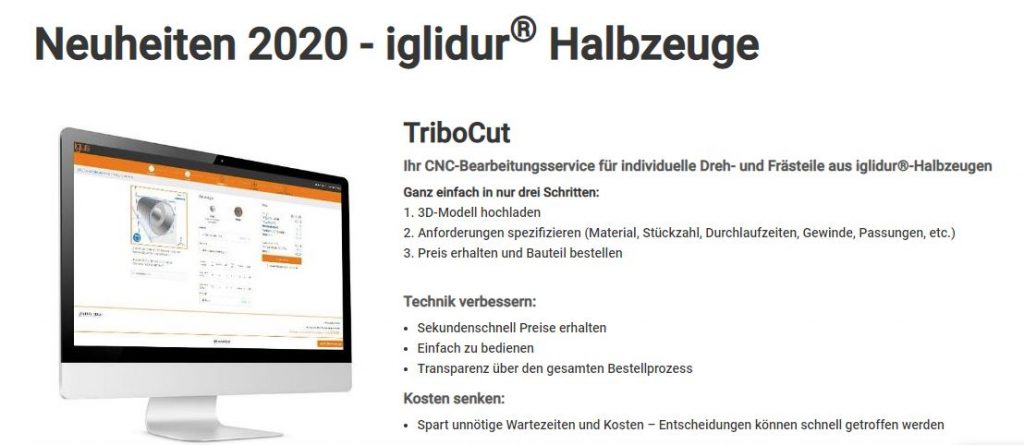Precise polymer bearing points in medical technology
Ulf Hottung | 5. June 2020
“Can’t be done!” say many design engineers and are therefore not generally wrong, but also not always right, especially in medical technology.
Correct is: polymer bearings, or bearing points in polymer in general, are subject to various factors that influence the preferred bearing clearance.
Impact on precision
Correct is: polymer bearings, or bearing points in polymer in general, are subject to various factors that influence the preferred bearing clearance.
The best known influencing factors are:
- Humidity and
- Temperature
Depending on the base material and supplementary materials, as well as the component geometry, 1/100mm and 1/10mm can come together there, which should be taken into account in the design.
The material characteristics play an important role here, because an unfilled PA6 can certainly “increase” in weight by more than 6 per cent when saturated by water, whereas POM and PEEK, for example, are around 1.3 and 0.5 per cent by weight respectively.
A further hundredth of an mm more bearing clearance may be required due to thermal expansion, which may be caused by temperature changes in the environment or by frictional heat.
Why should it be different in medical technology?
True, the influences are no different, but they are often easier to control.
Why? Most applications for plain bearings in medical technology are found in environments with relatively stable temperatures. The vast majority of medical practices, clinics and operating theatres are permanently temperature-controlled so that temperature fluctuations of more than 20°C can usually be excluded. Similarly, work is rarely carried out “under water”, which also reduces the influence of the moisture expansion in the components. Similarly, work is rarely carried out “under water”, which also reduces the influence of the moisture expansion in the components.
Precision in manufacturing
Likewise, in the case of injection moulded components, the manufacturing tolerances, which in turn depend not only on tool quality and machine settings, but also on the ambient conditions of production, which require tolerances of a few 1/100mm.
If, on the other hand, components are produced by machining, further improvements can be achieved with special measures. Keywords here are “material-compatible tempering” of raw materials, repeated processing steps to avoid material stresses such as displacement, heating and resetting.
I would be happy to discuss these topics from a “medical point of view” in further blog posts. Just send your request by clicking the following button, where you will find my e-mail address.
What else influences the precision of a bearing point?
Obviously the tolerances of the surrounding metal parts, such as shaft/axis/bolt and bearing support. The advantages of metals here are that moisture (without corrosion) will not lead to an increase in volume and the lower thermal expansion.
In the case of aluminium, however, care must be taken to ensure uniform temperatures again.
An example of consistent implementation is this slit lamp:
Slit lamps are used in ophthalmology, e.g. to optically examine the retina inside the eye or to treat blood vessels by “laser sclerotherapy”.
For this purpose, the macroscope attached to an extension arm, as well as the associated light source, must be light, jerk-free and movable without the user’s attention, since the 40x magnification in the stereo macroscope makes any “stumbling” more than obvious.

Why should plastic be used here?
This was also the reason why the designer of this device turned to igus a few years ago. Until then, the bearings were made of non-ferrous metal and steel and the supply and data cables were laid inside through the adjusting arms, which required apertures in the bearings.
Due to the complex mechanical processing and low wall thicknesses, it was extremely difficult to compensate for all tolerances and to reliably avoid the slightest burr residues. Lubrication was also required, but the grease changed its specifications over many years of use and the required quality criteria were difficult to ensure.
Plastic as a problem solver for high fitting quality
Plastic is softer than metal. That’s right. In this application, however, this is an extremely positive feature, and it has several advantages.
Due to the force application points for adjustment and weight force, which are about 250mm away from the bearing point, the arm is constantly pressed onto the edges of the bearing elements. Metal acknowledges this with material abrasion, the adhesion of abraded particles to the lubricant, as well as a non-constant surface impairment of both glide surfaces.
Plastic on the other hand is much softer and can be deformed. This results in larger contact surfaces, a lower compressive force and less wear … both on the metal and on the plastic.
Using iglidur J, the coefficient of friction is already so good that an initial lubrication (no metallic abrasion particles) is sufficient for the service life.
Likewise, the edges and burrs produced during the milling of the cable bushings are so soft that they neither disturb the movement nor cause additional wear.
But without knowledge it doesn’t work either
To further increase the stiffness, two more techniques were applied, which work at defined room temperatures and humidity limits.
- The polymer bearing designed with a 1.5mm thin wall and a maximum of 12 µm overlap would result in underutilisation of all tolerances.
- Due to the openings in the wall, the displaced volume can move there so that thermal calibration is no longer necessary.
Our new iglidur Designer is ideal for the preliminary design of free contours. Here the production possibilities from iglidur bar stock are already checked online with standard tolerances. If you have higher precision requirements, please use the text field or contact me directly.

https://www.igus.eu/info/n20-tribocut?L=en
Kind regards,
Ulf Hottung

